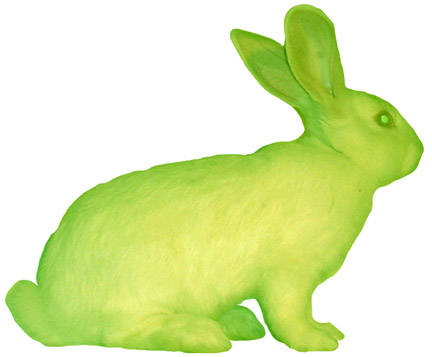
Photo by Chrystelle Fontaine
Transcription/Translation with pGLO
BACKGROUND
In 1992, researchers isolated the gene encoding the green fluorescent protein
from the jellyfish Aequorea victoria. The three dimensional structure
of the protein is such that it absorbs energy when exposed to ultraviolet light
and gives off some of this energy in the form of visible green light. Shortly
after cloning the GFP gene, researchers demonstrated that the GFP protein is
functional in a host of organisms. Because the fluorescence is easy to detect,
it has been used extensively as a reporter gene. In this experiment, we will
transform bacteria with a plasmid containing a modified version of the GFP gene (pGLO) and observe
the effect this exogenous DNA has on the phenotype of the recipient bacteria.
GOALSA
Investigate transcription and translation
Learn the technique of bacterial transformation
Calculate transformation efficiencies
Learn basic bacterial manipulations
Think about experimental design and data analysis
Alba, the fluorescent bunny

Photo by Chrystelle Fontaine
MATERIALS
Escherichia coli strain HB101on LB plate
1% tryptone
0.5% yeast extract
1% NaCl
1.5% agar
pH 7.0
1 LB plate
2 LB/ampicillin plates
1 LB/ampicillin/arabinose plate
pGLO plasmid DNA (0.08ug/ul)
50mM CaCl2 (transformation buffer)
LB broth
PROTOCOL
Prior to lab: E. coli in liquid culture was streaked on LB plates to
produce single, isolated colonies. These plates were incubated overnight at
37oC.
Day 1:
To each of two microfuge tubes, add 250ul of
transformation buffer. Keep these tubes on ice.
Using a sterile loop, pick one colony of bacteria from the LB plate.
Transfer this colony to one of the microfuge tubes. Gently vortex the tube
until the colony is dispersed. Repeat for the second tube.
Add 0.08ug of DNA to one of these tubes (+DNA
tube).
Incubate both tubes on ice for 10 minutes.
Incubate both tubes at 42oC for 50 seconds.
Incubate both tubes on ice for 2 minutes.
Add 250ul of LB broth to each tube and incubate
at room temperature for 10 minutes.
Flick each tube gently. Add 100ul of this transformation
mix to the appropriate plates.
+DNA: LB/amp
+DNA: LB/amp/ara
-DNA: LB/amp
-DNA: LB
Using a sterile cell spreader, spread the transformation
mix evenly across the surface of the plate.
Label each plate with your name and incubate upside down in the 37oC
incubator for 24 hours.
Day 2:
Remove your plates from the incubator and examine them under normal light and
under UV light.
Record your observations.
Calculate the transformation efficiency.
QUESTIONS
What role does ampicillin play in this experiment?
What role does arabinose play in this experiment?
Because the GFP was isolated from a jellyfish, what modifications to the GFP
DNA had to be made to result in expression in E. coli?
If you observed colonies on the +DNA: LB/amp plate, but these colonies did not
fluoresce, what would you conclude? How could you test your hypothesis?
For more information about GFP, check out this link from Connecticut College:
GFP
Background
Click here for more information on Alba,
the fluorescent bunny.